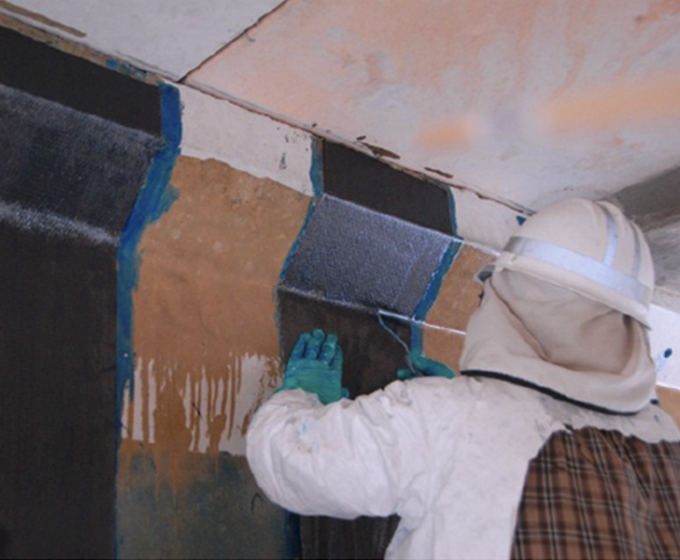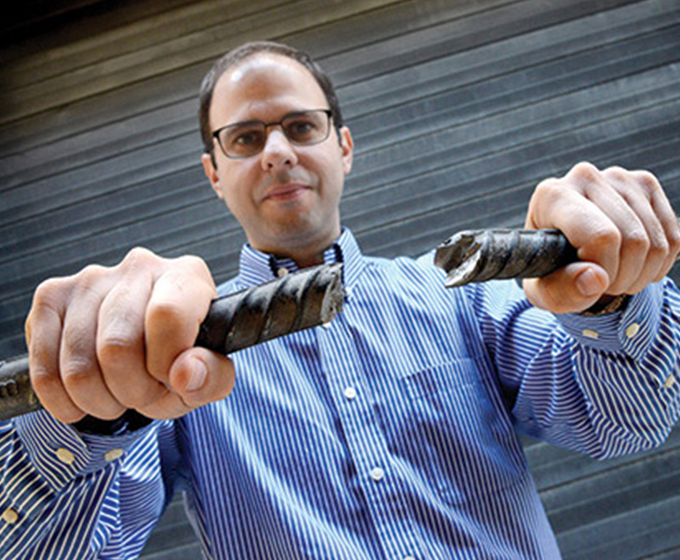
UTSA professor Wassim Ghannoum has perfected a method to strengthen and repair bridges and other concrete structures using strips of paper-thin carbon fiber reinforced polymers. His method is stronger, safer, and more cost- and time-efficient.
MARCH 30, 2021 — The next time you drive over a repaired bridge, you may want to thank a UTSA professor for keeping it safe with fewer traffic delays. Wassim Ghannoum, associate professor in the Department of Civil and Environmental Engineering, spent the last 10 years perfecting a method to strengthen and repair deficient bridges and other concrete structures using carbon fiber reinforced polymers—or CFRP.
Ghannoum documented his findings in a research paper submitted for peer review to the American Concrete Institute (ACI). His dedication to this research stood out among many other papers for a prestigious industry honor. Ghannoum was selected to receive ACI’s Wason Medal for Most Meritorious Paper, bestowed specifically for the “characterization of shear strengthening behavior of CFRP anchors and anchored strips” as co-author of the paper.
Ghannoum will receive the Wason Medal on March 31 at ACI’s Spring 2021 Concrete Convention, taking place virtually this year. His research and paper was funded by the Texas Department of Transportation.
“I’m recognized for uncovering the complex interactions between the carbon fiber and the concrete and steel materials as they work together,” Ghannoum said. “My sponsor, TxDOT, is aware of the award and is very happy to see our research be recognized at this level. It puts TxDOT and UTSA on the map for producing the highest quality of research.”
Structural engineers have been using carbon fiber sheets in bridge repair for many years but with mixed results. Ghannoum says the biggest weakness with this process is the bond between the carbon and the concrete. When concrete is overstressed it crumbles and peels off the carbon fiber sheet with it.
 Wassim Ghannoum researches the design and behavior of reinforced concrete structures.
Wassim Ghannoum researches the design and behavior of reinforced concrete structures.TxDOT funded Ghannoum’s research to find a way to take CFRP repair to the next level. Instead of using sheets by themselves to cover cracks and fractures, Ghannoum developed a unique approach by taking the carbon fiber and cutting it into strips called, anchors. These anchors made from strips of carbon fiber are folded over, coated with a special epoxy and inserted into holes about six inches deep drilled in a pattern around the damaged or weak area on a bridge. There’s a portion of the anchor that extends past the drilled hole. That portion is fanned out against the concrete and then covered with a specialized sheet of epoxied carbon fiber. This process has been working incredibly well with no known failures on bridges where applied.
“Carbon fiber is wonderful because if you anchor it properly, the way we demonstrate, you can increase the strength of bridges up to 50%,” Ghannoum said. “A 50% increase of a massive bridge section, by applying something as thin as wall paper, is not a small thing.”
Ghannoum added that carbon fiber is ideal for this application because of its phenomenal strength-to-weight ratio. Another benefit of carbon fiber reinforced polymers are their ability to move with the underlying bridge when put under a strenuous load. Engineers call this deformation compatibility. A material that is too flexible would not pick up enough of the load under traffic, while a material that is too stiff would pick up too much of the load and break under pressure. Thus, carbon fiber has the right stiffness and strength to work superbly in this application.
Ghannoum’s discovery not only makes bridges stronger and safer, but also generates huge cost savings with everything from materials to labor and commerce. Because of its widespread use in manufacturing anything from musical instruments to high-performing vehicles, it’s readily available in large, high-quality quantities.
It’s also a time-saver. Bridge repair traditionally involves closing the structure and rerouting traffic. Workers arrive to remove the damaged portion before building forms to tie in rebar and pour concrete. It can take about 10 days for concrete to cure and gain strength. At this point, the bridge is tested under load before reopening. During this time, traffic is rerouted causing travel delays and disruption for homes and businesses along the detoured path. In comparison, Ghannoum’s process takes a fraction of the time with better results.
“From a user’s perspective, you don’t close traffic because you can apply the carbon fiber anchor system in such a fast time,” Ghannoum said. “Instead of days, you can repair the bridge with a half day of work, so it’s a game-changer in that regard.”
Despite its many advantages, the carbon fiber anchor system is still gaining understanding and acceptance throughout the engineering and construction industry. Ghannoum is frequently invited to speak at conferences to share his findings that promise to forever change the way bridges are repaired in the United States and the world.
UTSA Today is produced by University Communications and Marketing, the official news source of The University of Texas at San Antonio. Send your feedback to news@utsa.edu. Keep up-to-date on UTSA news by visiting UTSA Today. Connect with UTSA online at Facebook, Twitter, Youtube and Instagram.
Move In To COLFA is strongly recommended for new students in COLFA. It gives you the chance to learn about the Student Success Center, campus resources and meet new friends!
Academic Classroom: Lecture Hall (MH 2.01.10,) McKinney Humanities BldgWe invite you to join us for Birds Up! Downtown, an exciting welcome back event designed to connect students with the different departments at the Downtown Campus. Students will have the opportunity to learn about some of the departments on campus, gain access to different resources, and collect some giveaways!
Bill Miller PlazaJoin us for an intimate evening of cocktails, conversation, and culinary inspiration with Pati Jinich, Emmy-nominated chef and James Beard Award-winning author. Enjoy light bites and signature drinks in the warm, modern setting of Mezquite as Pati connects with guests over her passion for Mexican cuisine and storytelling.
Mezquite Restaurant in Pullman Market, 221 Newell Ave., San Antonio 78215From inspired courses to thoughtful pairings and a rich sense of community, the Ven a Comer Signature Dinner is a night of shared meals, shared stories, and unforgettable flavor.
Stable Hall (Pear Brewery), 307 Pearl Pkwy, San Antonio 78215Come and celebrate this year's homecoming at the Downtown Campus with food, games, giveaways, music, and more. We look forward to seeing your Roadrunner Spirit!
Bill Miller PlazaThe University of Texas at San Antonio is dedicated to the advancement of knowledge through research and discovery, teaching and learning, community engagement and public service. As an institution of access and excellence, UTSA embraces multicultural traditions and serves as a center for intellectual and creative resources as well as a catalyst for socioeconomic development and the commercialization of intellectual property - for Texas, the nation and the world.
To be a premier public research university, providing access to educational excellence and preparing citizen leaders for the global environment.
We encourage an environment of dialogue and discovery, where integrity, excellence, respect, collaboration and innovation are fostered.